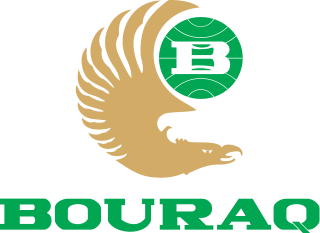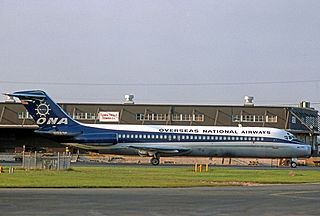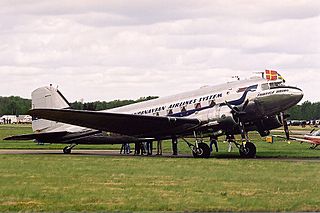
Indian Airlines was a division of Air India Limited. It was based in Delhi and focused primarily on domestic routes, along with several international services to neighbouring countries in Asia. It was a division of Air India Limited after merger of eight pre-Independence domestic airlines.
Samoa Airways, formerly Polynesian Airlines, is the state-owned flag carrier airline of Samoa.

Bouraq Indonesia Airlines, often shortened to Bouraq Airlines or just Bouraq, was an airline headquartered in Jakarta, Indonesia, which operated mostly domestic passenger flights out of its bases at Soekarno-Hatta International Airport and Sultan Aji Muhammad Sulaiman Airport.
Spantax S.A. was a Spanish leisure airline headquartered in Madrid that operated from 6 October 1959 to 29 March 1988. Spantax was one of the first Spanish airlines to operate tourist charter flights between European and North American cities and popular Spanish holiday destinations and was considered a major force in developing 20th-century mass tourism in Spain. Its popularity and image faded from the 1970s onward when a series of crashes and incidents revealed safety deficits, which, combined with rising fuel costs and increasing competition, resulted in the company facing severe financial difficulties that led to its demise in 1988.

Daytona Beach International Airport is a county-owned airport located three miles (5 km) southwest of Daytona Beach, next to Daytona International Speedway, in Volusia County, Florida, United States. The airport has 3 runways, a six-gate domestic terminal, and an international terminal. Daytona Beach is the headquarters of Embry-Riddle Aeronautical University.

ALM Antillean Airlines Flight 980 was a flight scheduled to fly from John F. Kennedy International Airport in New York City to Princess Juliana International Airport in St. Maarten, Netherlands Antilles, on 2 May 1970. After several unsuccessful landing attempts, the aircraft's fuel was exhausted, and it made a forced water landing (ditching) in the Caribbean Sea 48 km off St. Croix, with 23 fatalities and 40 survivors. The accident is one of a small number of intentional water ditchings of jet airliners.

One-Two-GO Airlines Flight 269 (OG269) was a scheduled domestic passenger flight from Bangkok to Phuket, Thailand. On 16 September 2007, about 15:41 ICT, the McDonnell Douglas MD-82 operating the flight crashed into an embankment beside runway 27 at Phuket International Airport (HKT) bursting into flames upon impact during an attempted go-around after an aborted landing, killing 90 of the 130 persons on board. It is the third deadliest aviation incident to occur in Thailand.

The 1950 Heathrow BEA Vickers Viking crash occurred on 31 October 1950 when a Vickers Viking operated by British European Airways (BEA) crashed at London Airport in heavy fog. The aircraft was on a scheduled flight between Paris and London's Northolt airport and 28 of the 30 passengers and crew on board were killed.

The 1947 Croydon Dakota accident occurred on 25 January 1947 when a Spencer Airways Douglas C-47A Skytrain (Dakota) failed to get airborne from Croydon Airport near London, and crashed into a parked and empty ČSA Douglas C-47 destroying both aircraft and killing 11 passengers and one crew member.

The 1958 Channel Airways de Havilland DH.104 Dove crash occurred on 15 January 1958, when a de Havilland DH.104 Dove of Channel Airways crashed on approach to Ferryfield Airport, Lydd, Kent due to mismanagement of the aircraft's fuel system by the pilot. All seven people on board survived, but the aircraft was written off.

British Overseas Airways Corporation (BOAC) was the British state-owned airline created in 1939 by the merger of Imperial Airways and British Airways Ltd. It continued operating overseas services throughout World War II. After the passing of the Civil Aviation Act 1946, European and South American services passed to two further state-owned airlines, British European Airways (BEA) and British South American Airways (BSAA). BOAC absorbed BSAA in 1949, but BEA continued to operate British domestic and European routes for the next quarter century. A 1971 Act of Parliament merged BOAC and BEA, effective 31 March 1974, forming today's British Airways. For most of its history its main rival was Pan Am.









